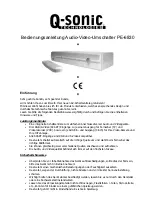
888
User Guide
45
Timecode mode
Sound Devices recorders offer multiple timecode modes. Different
modes correspond to different timecode workflows. Common modes
available in Sound Devices recorders include:
Record run - timecode advances only when recording is engaged.
Free run - timecode run continuously, typically with the start of
production being at 0 hour.
24 hour - similar to free run except the start time corresponds to time-
of-day.
Ext TC - the recorder applies the value of an external timecode source.
Tone oscillator
A sound generator producing a sine wave tone at a given frequency at
a given output level. With its known output level tone oscillators are
helpful to set gain structure between audio equipment.
Track
A single recorded audio signal. Common recorded tracks are the main
left/right master audio bus and isolated (ISO) channel recordings. ISO
tracks are typically identified by the channel of the same number, e.g.
channel 1 is sent to track 1, channel 2 is sent to track 2, etc.
Track arm
Tracks that are active and ready for recording are said to be “armed”.
When recording begins all armed tracks begin recording. Depending
on the production is may be advantageous to arm and disarm tracks,
especially to disarm unused tracks.
Track name
Individual tracks of a multi-track recording can be named to indicate
microphone type or character name.
Trim
Also defined in mixers as “gain”, the trim adjustment is the first
stage of gain of a microphone or line level input. Typical microphone
trim values range from 10 dB to 50 dB, depending on microphone
sensitivity and volume of the sound source.
User bits
Static, numeric data that is available as part of a timecode signal.
User bits are often used to indicate the date of a file. User bits are
four sets of two-digit hexadecimal numbers from 00 to ff.
WAV File
A universal, well-supported file type for sound file recordings. WAV files
can contain one or more (up to 65,535) tracks of PCM audio data at
any sampling rate and bit depth. A standard WAV file is limited to a
maximum file size of 4 GB. Sound Devices uses the WAV extension for
recorded files, including for files with Broadcast WAV metadata and
WAV RF64 files.
WAV RF64
An extension of the WAV file type that supports file sizes larger than 4
GB. When recording high track count, high sampling rate polyphonic
WAV files, the 4 GB size limitation of WAV can be reached quickly.
RF64 files larger than 4 GB require recording to a volume type than
can support file sizes larger than 4 GB.
Word clock
A reference signal used to synchronize the sampling rate of multiple
digital devices.
XLR female
Industry-standard 3-pin locking audio connector for microphone and
line-level sources. Predominantly used as an input. Also shown as
XLR-F
XLR male
Industry-standard 3-pin locking audio connector for microphone and
line-level sources. Predominantly used as an output. Also shown as
XLR-M





































